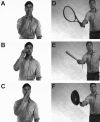Gesture discrimination in primary progressive aphasia: the intersection between gesture and language processing pathways
- PMID: 20445059
- PMCID: PMC6632725
- DOI: 10.1523/JNEUROSCI.0321-10.2010
Gesture discrimination in primary progressive aphasia: the intersection between gesture and language processing pathways
Abstract
The issue of the relationship between language and gesture processing and the partial overlap of their neural representations is of fundamental importance to neurology, psychology, and social sciences. Patients suffering from primary progressive aphasia, a clinical syndrome characterized by comparatively isolated language deficits, may provide direct evidence for anatomical and functional association between specific language deficits and gesture discrimination deficits. A consecutive series of 16 patients with primary progressive aphasia and 16 matched control subjects participated. Our nonverbal gesture discrimination task consisted of 19 trials. In each trial, participants observed three video clips showing the same gesture performed correctly in one clip and incorrectly in the other two. Subjects had to indicate which of the three versions was correct. Language and gesture production were evaluated by means of conventional tasks. All participants underwent high-resolution structural and diffusion tensor magnetic resonance imaging. Ten of the primary progressive aphasia patients showed a significant deficit on the nonverbal gesture discrimination task. A factor analysis revealed that this deficit clustered with gesture imitation, word and pseudoword repetition, and writing-to-dictation. Individual scores on this cluster correlated with volume in the left anterior inferior parietal cortex extending into the posterior superior temporal gyrus. Probabilistic tractography indicated this region comprised the cortical relay station of the indirect pathway connecting the inferior frontal gyrus and the superior temporal cortex. Thus, the left perisylvian temporoparietal area may underpin verbal imitative behavior, gesture imitation, and gesture discrimination indicative of a partly shared neural substrate for language and gesture resonance.
Figures




Similar articles
-
Middle longitudinal fascicle is associated with semantic processing deficits in primary progressive aphasia.Neuroimage Clin. 2020;25:102115. doi: 10.1016/j.nicl.2019.102115. Epub 2019 Dec 4. Neuroimage Clin. 2020. PMID: 31865024 Free PMC article.
-
Recognition and imitation of pantomimed motor acts after unilateral parietal and premotor lesions: a perspective on apraxia.Neuropsychologia. 2001;39(2):200-16. doi: 10.1016/s0028-3932(00)00088-9. Neuropsychologia. 2001. PMID: 11163376
-
Left inferior parietal dominance in gesture imitation: an fMRI study.Neuropsychologia. 2005;43(7):1086-98. doi: 10.1016/j.neuropsychologia.2004.10.004. Epub 2005 Jan 5. Neuropsychologia. 2005. PMID: 15769494 Clinical Trial.
-
The neural basis of syntactic deficits in primary progressive aphasia.Brain Lang. 2012 Sep;122(3):190-8. doi: 10.1016/j.bandl.2012.04.005. Epub 2012 Apr 29. Brain Lang. 2012. PMID: 22546214 Free PMC article. Review.
-
Disruption of structural connectivity along the dorsal and ventral language pathways in patients with nonfluent and semantic variant primary progressive aphasia: a DT MRI study and a literature review.Brain Lang. 2013 Nov;127(2):157-66. doi: 10.1016/j.bandl.2013.06.003. Epub 2013 Jul 26. Brain Lang. 2013. PMID: 23890877 Review.
Cited by
-
Neural representations of faces and limbs neighbor in human high-level visual cortex: evidence for a new organization principle.Psychol Res. 2013 Jan;77(1):74-97. doi: 10.1007/s00426-011-0392-x. Epub 2011 Dec 3. Psychol Res. 2013. PMID: 22139022 Free PMC article. Review.
-
Core auditory processing deficits in primary progressive aphasia.Brain. 2016 Jun;139(Pt 6):1817-29. doi: 10.1093/brain/aww067. Epub 2016 Apr 9. Brain. 2016. PMID: 27060523 Free PMC article.
-
Homuncular mirrors: misunderstanding causality in embodied cognition.Front Hum Neurosci. 2014 May 13;8:299. doi: 10.3389/fnhum.2014.00299. eCollection 2014. Front Hum Neurosci. 2014. PMID: 24860479 Free PMC article. No abstract available.
-
Beat and metaphoric gestures are differentially associated with regional cerebellar and cortical volumes.Hum Brain Mapp. 2015 Oct;36(10):4016-30. doi: 10.1002/hbm.22894. Epub 2015 Jul 14. Hum Brain Mapp. 2015. PMID: 26174599 Free PMC article.
-
Right hemisphere recruitment during language processing in frontotemporal lobar degeneration and Alzheimer's disease.J Mol Neurosci. 2011 Nov;45(3):637-47. doi: 10.1007/s12031-011-9603-6. Epub 2011 Aug 9. J Mol Neurosci. 2011. PMID: 21826394
References
-
- Barsalou LW. Grounded cognition. Annu Rev Psychol. 2008;59:617–645. - PubMed
-
- Bastiaanse R, Bosje M, Visch-Brink E. Psycholinguïstische testbatterij voor de taalverwerking van Afasiepatiënten (PALPA) Hove, UK: Lawrence Erlbaum Associates; 1995.
-
- Bates E, Dick F. Language, gesture, and the developing brain. Dev Psychobiol. 2002;40:293–310. - PubMed
-
- Behrens TE, Woolrich MW, Jenkinson M, Johansen-Berg H, Nunes RG, Clare S, Matthews PM, Brady JM, Smith SM. Characterization and propagagion of uncertainty in diffusion-weighted MR images. Magn Reson Med. 2003;50:1077–1088. - PubMed
Publication types
MeSH terms
LinkOut - more resources
Full Text Sources
